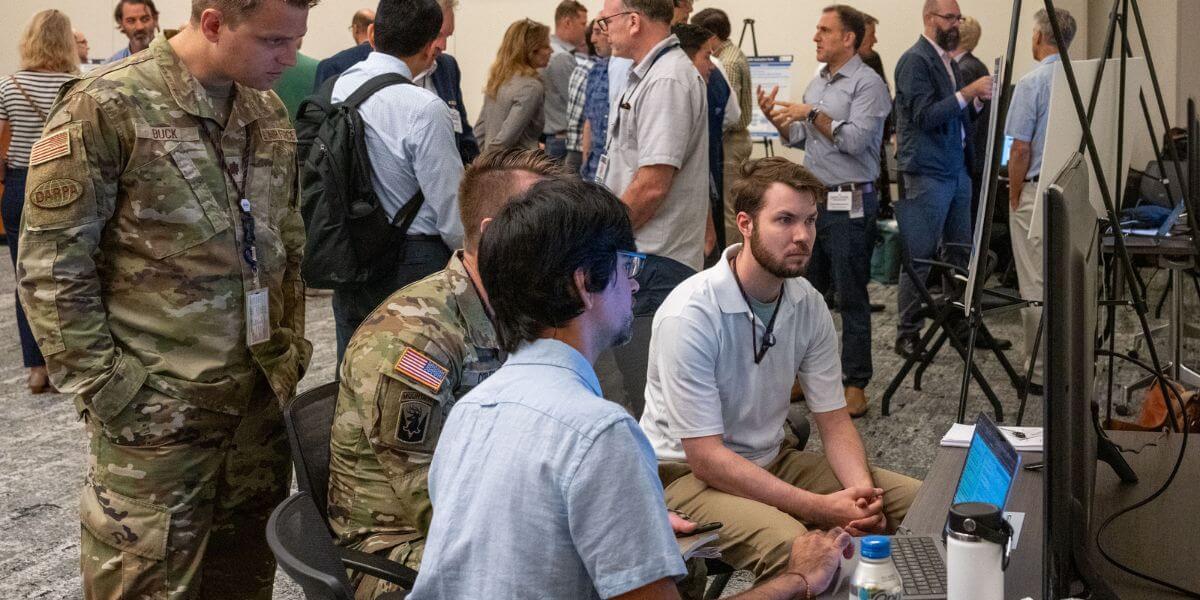In August 2025, USC Viterbi’s Information Sciences Institute (ISI) was among the leading international research teams brought together by the Defense Advanced Research Projects Agency (DARPA) in Arlington, Virginia, for the final showcase of its Knowledge Management at Scale and Speed (KMASS) program. Led by Jay Pujara, director of ISI’s Center on Knowledge Graphs, the ISI team had spent the previous two years working on KMASS, an initiative designed to tackle one of the most persistent and costly challenges facing organizations: the erosion of knowledge that occurs as experienced personnel depart, retire, or transition to new roles.
This proactive approach to knowledge delivery addresses a fundamental limitation of traditional information retrieval systems, which typically require users to already understand what they need to know before they can search for it, creating a paradoxical barrier to learning and problem-solving in complex operational environments. KMASS supports projects that help organizations capture, organize, and deliver critical information when it is needed, even if the user does not know what to ask.
Pujara, who is a research associate professor of computer science at USC Viterbi School of Engineering, presented Knowledge Needed in Context (KNIC), a system that observes how people work, captures their process, and provides timely, task-relevant guidance to others performing similar jobs.
The audience included professionals from domains such as intelligence analysis and resource allocation, who, Pujara said, “could immediately see how this could be applied in their workflows.” DARPA’s own writeup, published shortly after the event, summed up the program’s vision with the headline: “Don’t just ask a chatbot. Have it push useful info right when it’s needed.”
A Smarter Way to Transfer Knowledge
“It’s really hard to transfer all of the institutional knowledge that someone has when they leave a position,” Pujara said. “That’s a pretty universal problem.” KNIC is designed to act like a digital apprentice. It quietly observes experienced users as they work, identifies how they complete tasks, and captures that process for future users to follow when they encounter similar problems.
KNIC tackles this problem by breaking it up into three areas. The first is knowledge capture, where the system observes expert practitioners in real-time and extracts patterns from their methodologies and decision-making processes. The second is knowledge storage, where it creates structured representations of those tasks. And the third is knowledge dissemination, where the system provides relevant examples from past work to users at the moment they need them most, delivering the right information at the right time to support their current tasks.
“We’ve all had the experience of trying to write down everything we know for the next person,” said Pujara. “Instead, our system watches what you do, summarizes your actions, and asks questions to fill in the gaps.”
The system also minimizes interruptions. KNIC ranks its own confidence before engaging the user, aiming to be helpful without getting in the way. “It’s like having an apprentice who knows when to ask and when to stay quiet,” Pujara said. “We wanted it to support people without disrupting their work.”
Real Systems, Real Workflows
The system was first deployed in the context of data science, where it observed users in Jupyter Notebooks, an interactive programming tool commonly used by scientists and engineers to write and run code. There, it learned how analysts approached tasks like writing code or analyzing data, and then helped newcomers follow that same process. KNIC was later integrated integrated with a platform developed by InferLink and used by the government for extraction and analysis from articles, contracts, tables and other documents.
Unlike most large language model (LLM) tools, KNIC does not generate answers probabilistically. As Pujara explained: “We pull real examples from your organization. Things real people actually did. You get zero hallucination, and more importantly, you learn by doing, not by copying AI.”
What Comes Next
The KMASS program officially concluded on September 20, 2025, but ISI’s work continues. With the research phase complete, Pujara said, “The fun part is over. Now we’re making sure what we built gets used.” That next step involves moving KNIC from lab demonstrations into real deployments. While DARPA’s program centered on government needs, Pujara noted that the same approach could benefit large enterprises, research institutions, and other organizations that struggle with turnover or complex training.
As the program moves from research to real-world application, KNIC points toward a future where knowledge grows with organizations instead of disappearing when people leave. For sectors where experience is critical and mistakes are costly, that transformation cannot come soon enough.
Published on October 8th, 2025
Last updated on October 8th, 2025

